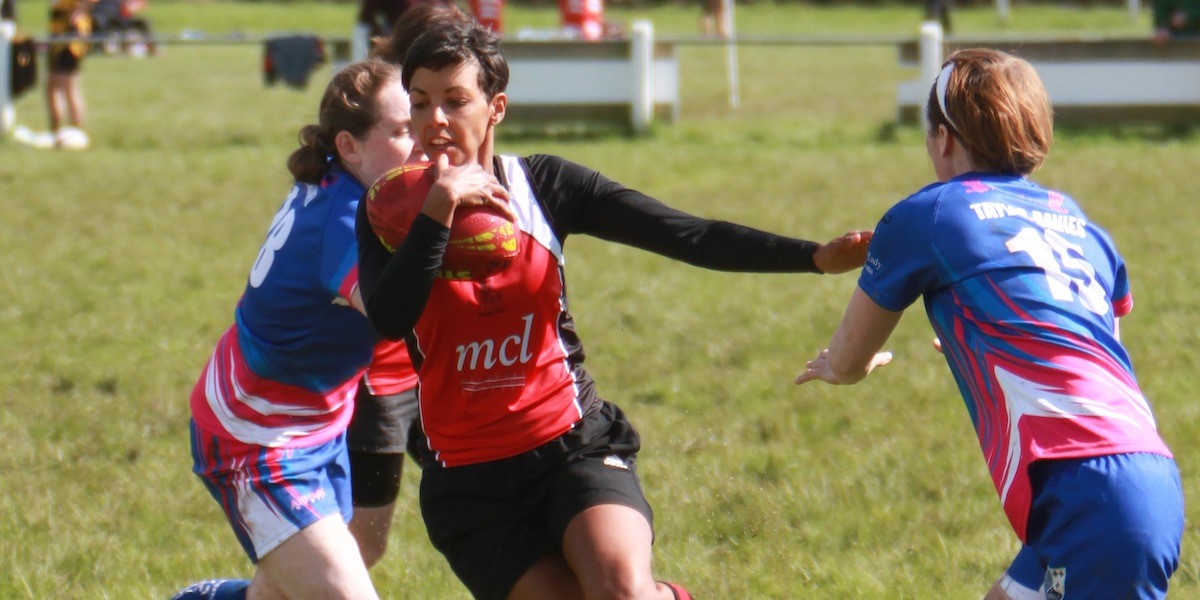Sign-up to receive all the latest news from England Touch
Midlands Ladies League looking good for a big year

After a two-year Covid hiatus, the Midlands Ladies Touch League is set to return with a flood of action across the region over the next eight months.
One of the country’s most established Touch leagues, the Midlands Ladies Touch League (MLTL) includes teams from a wide area, including Lichfield in Staffordshire and Nuneaton in north Warwickshire, through to Leominster and Ross-on-Wye, both in deepest Herefordshire.
In all, some 20 clubs have entered into the League, split into three, separate sub-regional competitions. Each club can host either a sub-regional tournament during the course of 2022, or one of three ‘all-team’ Super Sundays, the final of which, at Redditch in mid-October, will find the overall League champions.
Fizz Bewley, who has been administering the League for over a decade, says that she has been delighted by the response of all the teams to the prospect of returning to the field.
“There were no second thoughts about getting it back up and running,” she says. We had a friendly at Luctonians back in the autumn and everyone was so happy to be playing again. There were eight teams then and everyone’s keen to get back at it.
“It’s the easiest year I’ve ever had in terms of arranging fixtures and venues.”
The Midlands Ladies Touch League has been affiliated to England Touch for some time, but it is only since the pandemic that the national governing body has been able to offer more hands-on support, recognising the value in having an established competition in which women players can experience their first tournaments and then develop up to a high level.
“The Midlands Ladies Touch league has been going for a long time, and it existed before I became involved 10 years ago,” Fizz explains. “Initially it was set up by Steve Joslin, a Community Manager at Worcester Warriors, who saw the value in developing women’s teams, realised that Touch was great and there was an opportunity for ladies to take part.
“Initially there were five teams, and he went around clubs and introduced the idea to them, and it grew from there. It carried on growing because there was an organic demand for ladies Touch, for women who wanted to play a form of rugby but who didn’t want to get bashed about.
“Having the proper governing body of the sport involved is very powerful. It brings up more support and is refreshing to have. The more teams we have the better, and the more publicity we have the better. There’s a limit to what I can do as a volunteer administrator so having the ETA interested and involved is great. It can only be good for the league and its profile and encouraging more women to take part.
“The standard of the league has improved massively since it started. You are going to get better as time goes on, but rubbing shoulders with elite players who have come in to play in the league means that the standard improves.”
The League has also helped teams become valued parts of the rugby clubs where they have been based.
“All of the rugby clubs, who have ladies Touch teams that take part in the league, really value having them as part of their clubs, because of their desire to be inclusive and have women taking part in a form of rugby at their club,” says Fizz.
“This league provides a structure to support that happening, otherwise there might not be teams for them to play.”
The League may be outside the National Touch Series structure, but Fizz says that having strong administration and clear expectations of teams – not least in providing non-playing referees – helps maintain credibility and consistency across all of the regions.
“It’s important, when you’re running a league, to decide what its objectives are, and ours is to encourage as many women as possible to take part,” she says. “Beyond that, though, there is also an ambition to give women the opportunity to play at a good standard.
“It’s the same with refereeing, which has to be very good. We don’t want to play where it doesn’t matter if you don’t know the rules! At the beginning when I started to play, teams were putting up referees who didn’t know the rules and it was massively frustrating.
“That is partly what motivated me to become involved as administrator, because I thought: we’ve got to have a high standard of refereeing as it’s crucial to helping the league grow. Each team now has to have a non-playing referee who has taken the England Touch Level 1 theory course at least.
“The idea is for people to take part, but also for it to be a platform for people to improve.”
Having 20 teams makes the Midlands Ladies Touch League one of the largest regular competitions in the country, but Fizz insists that there is room for further growth, and ambition to achieve it as well.
“If you have a good model then you can scale it up,” she says. “We’ve produced a set of detailed guidelines on how host clubs stage a MLTL tournament, and in each of the sub-regions we have a co-ordinator who is in charge of making sure that teams host the events properly. So we can add on as many sub-regions as we need to as teams join, as long as they have a co-ordinator.
“So we do want more teams – the more the merrier!”
To find out more about the Midlands Ladies Touch League, whether as a player, team, referee or volunteer, email Fizz via fizz.bewley500@btinternet.com
Teams
Five Ways, Rugby SA, Old Laurentians, Lichfield, Nuneaton, Atherstone, Pershore, Ross, Luctonians, Berry Hill, Bredon, Ledbury, Malvern, Redditch, Stratford, Wellesbourne, Camp Hill, Woodrush, Kenilworth







